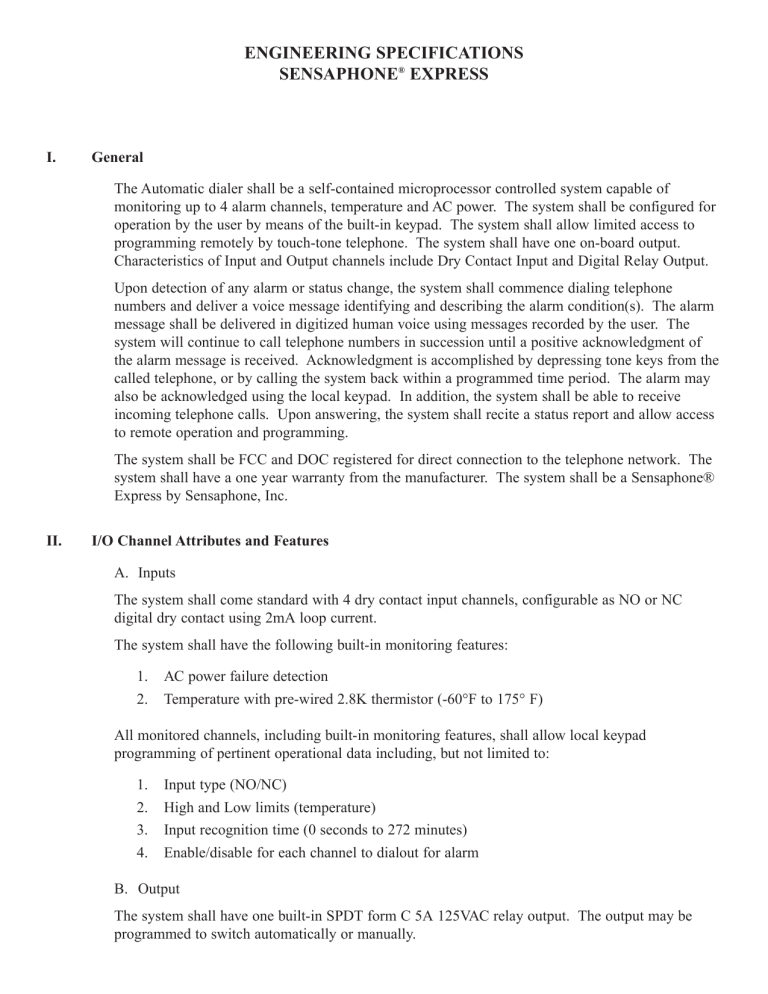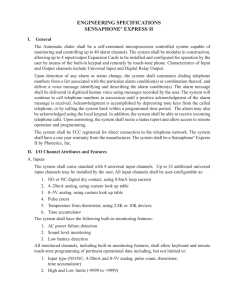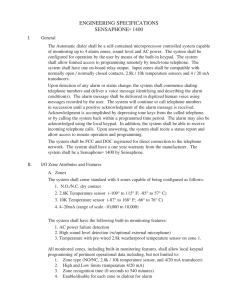ENGINEERING SPECIFICATIONS SENSAPHONE® EXPRESS

ENGINEERING SPECIFICATIONS
SENSAPHONE
®
EXPRESS
I.
General
The Automatic dialer shall be a self-contained microprocessor controlled system capable of monitoring up to 4 alarm channels, temperature and AC power. The system shall be configured for operation by the user by means of the built-in keypad. The system shall allow limited access to programming remotely by touch-tone telephone. The system shall have one on-board output.
Characteristics of Input and Output channels include Dry Contact Input and Digital Relay Output.
Upon detection of any alarm or status change, the system shall commence dialing telephone numbers and deliver a voice message identifying and describing the alarm condition(s). The alarm message shall be delivered in digitized human voice using messages recorded by the user. The system will continue to call telephone numbers in succession until a positive acknowledgment of the alarm message is received. Acknowledgment is accomplished by depressing tone keys from the called telephone, or by calling the system back within a programmed time period. The alarm may also be acknowledged using the local keypad. In addition, the system shall be able to receive incoming telephone calls. Upon answering, the system shall recite a status report and allow access to remote operation and programming.
The system shall be FCC and DOC registered for direct connection to the telephone network. The system shall have a one year warranty from the manufacturer. The system shall be a Sensaphone®
Express by Sensaphone, Inc.
II.
I/O Channel Attributes and Features
A. Inputs
The system shall come standard with 4 dry contact input channels, configurable as NO or NC digital dry contact using 2mA loop current.
The system shall have the following built-in monitoring features:
1.
AC power failure detection
2.
Temperature with pre-wired 2.8K thermistor (-60°F to 175° F)
All monitored channels, including built-in monitoring features, shall allow local keypad programming of pertinent operational data including, but not limited to:
1.
Input type (NO/NC)
2.
High and Low limits (temperature)
3.
Input recognition time (0 seconds to 272 minutes)
4.
Enable/disable for each channel to dialout for alarm
B. Output
The system shall have one built-in SPDT form C 5A 125VAC relay output. The output may be programmed to switch automatically or manually.
III.
Communications Features
A. Telephone Specifications
The system shall connect to a standard 2-wire telephone line using pulse or tone, with loop start only. The system shall recognize ringer frequencies from 16 to 60 Hz. No leased or dedicated lines shall be required. The system shall also be capable of being used on the same telephone line as other answering devices. Call progress detection shall ensure that the alarm dialout is not hindered by no answers or busy signals.
B. Telephone Numbers
The system shall be capable of dialing up to 8 telephone numbers, 32 digits each. The system shall allow local keypad programming of the following telephone dialing information:
1.
Dialing method (Pulse or tone)
2.
Message repetitions (0 to 255)
3.
Maximum number of calls (0 to 255)
4.
Call delay time (0 seconds to 255 seconds)
5.
Intercall delay time (0 seconds to 272 minutes)
6.
Redial on busy (enable/disable)
C. Voice Messages
The System shall have the ability to record, store and reproduce voice messages and to use those messages to articulate the location and status of the monitored channels. In absence of userrecorded voice messages, the system shall articulate channel status using the internally resident vocabulary. All digitized speech message data shall be stored in nonvolatile memory with a 3V lithium battery backup. Such battery backup shall be capable of protecting speech memory for at least 2 years of complete power outage.
There shall be one recorded identification message for the system, and one recorded alarm message for each input channel. Message length shall be 8 seconds per input channel and 10.5 seconds for the identification message.
D. Beeper/Pager Dialout
The system shall be capable of intelligently dialing out to a numeric beeper or pager. The dialing sequence shall be programmable such that the pager number is dialed, the system waits for the telephone to be answered, and then additional identification DTMF digits are transmitted.
E. Line Seizure Feature
The system automatically seizes control of the phone line to make an alarm phone call when the alarm occurs. All other calls, including current calls, will disconnect and all extensions will be disabled. Extensions will remain cut off until the alarm is acknowledged.
IV.
Programming
A. Local Programming
The System shall contain an integral, sealed keypad for the purpose of locally programming all system data. Programming is assisted by synthesized voice guidance.
V.
B. Remote Programming
The system shall be remotely programmable using a standard touch-tone telephone. Remote programming shall be aided by menu-style voice guidance. The following parameters may be remotely programmed:
1.
Alarm messages
2.
Identification message
3.
Turn output on/off
4.
Disable/enable inputs
Remote Operation Features
A. Status Report
The system shall allow the user to call into the unit at any time using any standard telephone to obtain a full status report of all monitored channels including present temperature and listen-in to on-site sounds. The status report shall be articulated using the resident voice-synthesized English vocabulary, in combination with digitized user-recorded voice messages.
B. Acknowledgment
An alarm on any monitored channel may be acknowledged remotely by pressing tones on a touchtone telephone keypad or by calling the system back within a specified time period. An alarm may also be acknowledged locally using the built-in keypad.
VI.
Enclosure and Environmental
A. Enclosure
The system shall be housed in a NEMA-4X fiberglass enclosure with a latched clear cover and shall be internally constructed to facilitate field upgrades, repair, and maintenance.
B. Power
The system shall be provided with a UL listed 12V AC power transformer that the user may plug into a 117V AC outlet, +20%, 60Hz.
C. Local Visual Indication
Each input shall have a corresponding LED that will indicate the alarm and acknowledgment status of each input.
D. Battery Backup
The system shall have a built-in 12V 1.9 AH sealed lead-acid rechargeable battery. This battery shall support approximately 12 hours of continued system operation in the absence of AC power.
E. Electrical Protection
Power and telephone connection shall have internal spike and surge protection using metal oxide varistors. The dry contact inputs shall be optically isolated.
F. Additional Electrical Surge Protection
Additional Power and Telephone line surge protection shall be available from the manufacturer.
When so installed, the system shall be fully warranted against any damage caused by transient surges entering the system through Power or Telephone lines.
G. Environmental
The system shall function over an operating range of 32° F - 120° F at up to 0 - 90% RH, noncondensing.
H. Maintenance
The system manufacturer shall have in-house service facilities and technical assistance available during normal business hours (EST).
Specifications subject to change without notice.
SENSAPHONE, INC.
901 Tryens Road
Aston, PA 19014
Phone: 610.558.2700 Fax: 610.558.0222
Sensaphone ® is a registered trademark of Phonetics, Inc.




